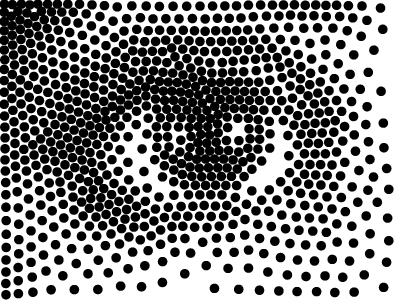
The images on the right use exactly the same number of colours (or grey tones), namely 4. This reduction in colours (from the original) is called "quantisation".
But the the bottom right image has had noise added prior to quantisation. While both of the images on the right have been quantised to a palette of 4 tones, the one on the bottom right provides for a more overt sense of tonal gradation than the top right. But how is it that adding noise results in better tonal quality?
Well the reason is that noise is not just noise. Statistically (and this is important) noise is equivalent to zero. So adding noise is the same as adding zero. In other words the result of adding noise is no change at all. But only statistically (ie. globally). Locally (for any given pixel) the effect is noise (randomness). But globally the noise filter doesn't do anything at all. It doesn't matter if the noise is pseudo-random or organically random - the result is the same: no change.
Now an image (a signal, a face) is not localised in any particular pixel. The image is a statistical object - distributed throughout all of the pixels - between every pixel and every other pixel. Accordingly the addition of noise has no affect on the image, since the noise only affects the pixels (the local information). It does not affect the image. At any given location (ie. at a pixel) the noise will have a random affect (resulting in any value) but globally (statistically) the noise filter is zero (has zero affect). Globally, for every pixel that is darker by some random amount, another is lighter by an equal but opposite amount. So globally these effects cancel each other out.
An image and the zero side of the noise addition, occupy the same domain - a statistical space, whereas the 4 colour filter occupies local space (the pixels). If the random aspect of the noise filter affects only the pixels, and not the image, it can be used to effectively interrupt the localised effect of the 4 colour process, while having no affect on the image. This affords the image a greater opportunity to punch through the barrier otherwise introduced by the 4 colour effect. The 4 colour effect is effectively turned to junk (noise) allowing the image (signal) to become consequently more visible.
The way in which film is constructed provides a ready-made inbuilt noise adder. During transfer to digital - the affect of such is to turn localised information (where quantisation occurs) into noise, while having no affect on the image. And insofar as this is done at the source (during exposure), rather than in post, the image is far better sustained. It is why adding noise in post is not as effective as adding noise at the source (in the way film is manufactured). It is why Peter Jackson's claims that you can add noise (or grain) in post falls down. The noise is not what we are appreciating (not normally). It is the image. But if the image is not there to begin with, the addition of noise won't help to recover it. The noise operates on localised information in order to unblock any image (global information) that might be lurking. But if the image is not there in the first place, no amount of unblocking will find it again. That said, there is still an image in the digital domain and one that the addition of some noise can unblock. Just not as effectively as doing so at the source.
This same thing also works in film projection as well. The cells on our retinas are localised sensors. The film interrupts any quantisation effects our eyes might contribute to a depreciation of the image. Our eyes have already done a lot of the work already - randomly arranged cells, random movement of the eyes. But our eyes are not there during film exposure, so the film has to do similar work. Scramble localisations before they infiltrate and subdue the image.
So in short adding noise does not affect the image. It only affects the quantisation which would otherwise (if not turned to noise) further suppress the image.
Carl

